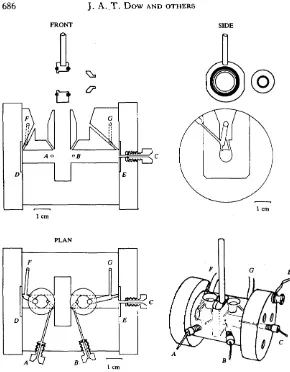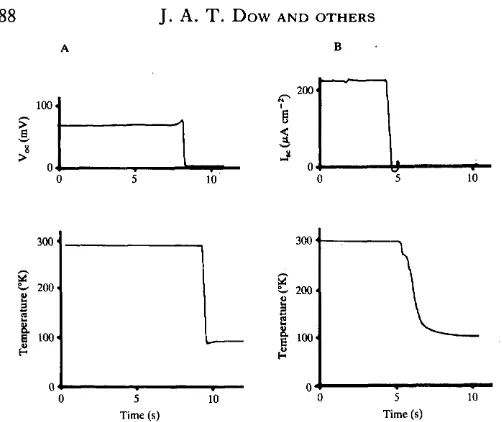Printed in Great Britain © The Company of Biologists Limited 1985
SHORT COMMUNICATION
AN IMPROVED CHAMBER FOR THE SHORT-CIRCUITING OF
EPITHELIA
BY JULIAN A. T. DOW*, WILLIAM R. HARVEY, MICHAEL G. WOLFERSBERGER AND BRUCE BOYESf
Department of Biology, and \C A S Machine Shop, Temple University, Philadelphia, PA 19122, U.SA.
Accepted 4 July 1984
Since the pioneering work of Ussing & Zerahn (1951), the design of short-circuit apparatus has been modified only slightly. Such chambers generally consist of two halves, between which the epithelium is stretched. The assembly is clamped together and filled with saline, which is circulated in each half chamber by gas lift pumps, usually connected to the main chamber with plastic pipes. There are two current electrodes, one at each end of the chamber, and - usually - two voltage-sensing electrodes close to the tissue. The current passed through the chamber is adjusted until the p.d. between the sensing electrodes becomes zero. Under such conditions, only actively transported ions move across the tissue, and the short-circuit current is a precise measure of the net flux of charged species. Short-circuiting is thus a method of choice for investigating transport phenomena in epithelia.
In this paper, we describe a chamber which differs significantly from the classical design, and illustrate its performance with specific reference to a tissue containing a potent electrogenic pump, the midgut of the lepidopteran larva, Manduca sexta (Harvey, Cioffi, Dow & Wolfersberger, 1983).
The chamber (Fig. 1) consists of a short cylinder of Perspex, drilled axially with an 8-mm hole. Current electrodes of thin silver sheet are held against either end by Perspex endplates (Fig. 1), which are held to the main chamber with screws. The central bore is divided into two chamber 'halves' by a milled slot, into which the tissue-bearing aperture (Fig. 1) is inserted. Three voltage-sensing electrodes (Ag/AgCl wires, insulated to 1 mm below the tip, for normal use, or agar bridges to calomel electrodes for Ag+-sensitive tissues) are inserted into the chamber, through rubber seals, on either side of the aperture (A-C in Fig. 1). The three electrode arrangement compensates for the resistivity of the saline, when this low resistivity tissue (10011cm2) is short-circuited (Wood & Moreton, 1978). Circu-lation of fluid is accomplished with gas-lift pumps, which are integral within the main chamber block. Gas (oxygen or nitrogen) is supplied at constant pressure to the two gas inlets (F,G, Fig. 1).
686
SIDE
1 cm
PLAN
1 cm
[image:2.451.82.372.128.500.2]1 cm
Fig. 1, Diagrams of the short-circuit chamber: front view, plan, end view and perspective sketch. The voltage-sensing electrodes (A,B,C), current electrodes (D,E) and gas inlet pipes {F,G) are labelled.
1.
0-5'
0 -A
200-i
100-30 Time (min)
60
Time (min)
Fig. 2. Effect of (A) anoxia and (B) l m m o l l ' sodium azide, on the short-circuit current of
Manduca midguts. In (A), the gut was short-circuited immediately upon assembly of the chamber,
2-8min after the start of dissection. In (B), the time scale is expanded, so that the time course of the effect can be seen.
688
B
B 100
5 Time (s)
[image:4.451.92.343.121.332.2]5 Time (s)
Fig. 3. Time course of quench freezing of a circuited tissue under open-circuit (A) or short-circuit (B) conditions. The upper traces show the open-short-circuit current (A) or short-short-circuit potential (B), recorded from the chamber; the lower traces show the temperature recorded by a thermocouple inserted into a fold in the epithelium.
amount of spray caused by gas bubbles bursting, in the reservoirs, the funnels machined above the reservoirs serve to catch the spray, rendering the chamber suitable for flux measurements with radioactive isotopes. As the pressure head on the gut is less than 2cmH2O, the tissue remains completely still in the chamber, even though the saline circulates rapidly. The small volume of circulating saline (under 3 ml in each chamber half) ensures very rapid mixing times, and thus the speed of current inhibition by anoxia (Fig. 2A) is greatly increased. The tissue begins to respond within 17s (compared with 2-3 min for the previous design). Thus the slower responses previously observed are more a function of slow gas exchange, than a gradual exhaustion of glycolytic or oxidative metabolic pathways, as has previously been suggested (Mandel, Riddle & Storey, 1980).
The rapid mixing time is even more impressive when azide is used to block oxidative metabolism. Here the only delays are the circulation time of the chamber halves, and the time for azide to penetrate the tissue. As shown in Fig. 2B, the current is affected within 2 s, and the half-time for inhibition is 29 s. This confirms that oxidative phosphorylation dominates the normal energy supply for the pump. The low basal rate of transport which sometimes remains after oxidative phosphory-lation has been inhibited may represent the contribution of glycolytic metabolism, other transport processes, or a residual error in short-circuiting.
micro-analytical studies of midgut function (Dow, Gupta, Hall & Harvey, 1984; Gupta, Dow, Hall & Harvey, 1985). Fig. 3 demonstrates that the tissue can be quenched within 1 0 s of short-circuiting within the chamber. Similarly the ability to transfer the tissue repeatedly from one chamber to another, perhaps containing different salines, opens exciting possibilities for tracer flux or ion-substitution experiments.
This work was supported by NIH grant AI-09503. JATD was supported by a Harkness Fellowship of the Commonwealth Fund, and is currently a Research Fellow of St Catharine's College, Cambridge.
R E F E R E N C E S
Dow, J. A. T., GUPTA, B. L., HALL, T. A. & HARVEY, W. R. (1984). X-ray microanalysis of elements in frozen-hydrated sections of an electrogenic K+
transport system: the posterior midgut of tobacco hornworm (Manduca sexta) in vivo and in vitro. J. Membrane Bio!. 77, 223—241.
GUPTA, B. L., DOW, J. A. T., HALL, T. A. & HARVEY, W. R. (1985). Electron probe analysis of the effects of
Bacillus thuringiensis var kurstaki 5-endotoxin on an electrogenic K"1
" transport system, the midgut of the larval lepidopteran, Manduca sexta, in vitro. J. Cell Sci. (in press).
HARVEY, W. R., CIOFFI, M., DOW, J. A. T. & WOLFERSBERGER, M. G. (1983). Potassium ion transport ATPase in insect epithelia. J . exp. Biol. 106, 91-117.
MANDEL, L. J . , RIDDLE, T. G. & STOREY, J. M. (1980). Role of ATP in respiratory control and active transport in tobacco hornworm midgut. Am.J. Physiol. 238, C10-C14.
SCHULTZ, T. W. & JUNGREIS, A. M. (1977). The goblet cavity matrix in the larval midgut of Hyalophora
cecropia. J. Insect. Physiol. 23, 29-32.
THOMAS, M. V. & MAY, T. E. (1984). Active potassium ion transport across the caterpillar midgut. I. Tissue electrical properties and potassium ion transport inhibition. J . exp. Biol. 108, 273—291.
USSING, H. H. &ZERAHN, K. (1951). Active transport of sodium as the source of electric current in the short-circuited isolated frog skin. Acta physiol. scand. 23, 110-127.
WOLFERSBERCER, M. G. & GIANGIACOMO, K. M. (1983). Active potassium transport by the isolated lepidopteran larval midgut: stimulation of net potassium flux and elimination of the slower phase decline of the short-circuit current. J. exp. Biol. 102, 199-210.

